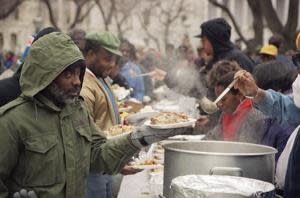 The Lookout
The LookoutWhat does it mean to be poor in America?

We learned Tuesday that a record number of Americans are living in poverty, and that the poverty rate--15.1 percent--rose for the fourth straight year.
But those raw numbers leave out some key details that can help us understand the fuller implications of how poverty affects individual Americans. For instance, how is poverty defined? What specific hardships do the poor suffer? And what does it mean to be poor in America today?
The Census Bureau defines as poor any individual living on an income of less than $11,139, or any family of four living on less than $22,314. But that measure, developed over 40 years ago, is inexact at best. It doesn't include non-cash benefits--things such as food and housing subsidies--that can play a key role in supporting families. Nor does the Census definition take into account the large differences in the cost of living in different part of the country, or expenses such as child-care.
So from the outset, we lack a fully accurate way of gauging Americans' true economic well-being. That's why the Census Bureau said in its report that it plans to unveil preliminary findings next month, derived from a new measurement that addresses some of the shortcomings in the current system.
More fundamentally, some argue that in today's economy, the very term "poverty" can be misleading. A report by the conservative Heritage Foundation notes that when most Americans hear the word, they think of people who routinely can't afford the basic staples of life: nutritious food, shelter and clothing. In reality, data from other federal surveys suggests that's not the case for most poor people. And thanks to steadily increasing living standards, many or most poor Americans have things such as internet service, cable TV and dishwashers--not luxuries, to be sure, but not the picture of destitution that the word poverty often brings to mind.
As the report's authors, Robert Rector and Rachel Sheffield put it: "[T]he actual standard of living of America's poor—in terms of amenities in the home, housing, food consumption, and nutrition—is far higher than expected."
Advocates for a greater focus on poverty acknowledge that basic accuracy of the claim advanced by the authors of the Heritage report--that standards of living for the poor are much higher than they were a few decades ago, and better than many people imagine. But they also say this qualified account of what it means to be poor the doesn't tell the whole story, either.
"It's important, but there's a lot more to say," Ron Haskins of the Brookings Institution told The Lookout.
There's certainly plenty of evidence to suggest that, in spite of poor families' ready access to some consumer amenities, they can face severe challenges in meeting basic needs. According to a U.S. Department of Agriculture report released this month, 14.5 percent of American households--more than 17.2 million households, in all--were defined as "food insecure" last year. That means that poor households lacked sufficient money or other resources to obtain access to adequate food supplies. Among those with incomes near or below the poverty line, rates of food insecurity were said to be "substantially higher."
As Rector noted in an interview with The Lookout, food insecurity doesn't necessarily mean that poor familiers were malnourished, because the problem may only have lasted a short time. Still, it's a hardship most better-off Americans don't imagine facing.
And access to the basic necessities isn't the only issue. "The poor compared with other groups in the United States have a much more difficult day-to-day existence," Haskins said. "We know that things like having your electricity turned off, not being able to make your house or car payments, having to double up and live with other people, that is much more frequent among the poor." Poverty also correlates closely with school dropout rates and teen pregnancy, Haskins added.
"This is not Bangladesh, but there still is a lot of misery," he said.
Haskins also noted that an array of government programs have helped ensured that the proportion of Americans in poverty isn't larger still. "Public policy does a hell of a lot for poor people," he said. "The poverty rate would be much higher [without such programs]" According to the Census Bureau report, Social Security and unemployment benefits alone kept 23.5 million Americans out of poverty.
Some argue that even if poor Americans are doing OK by some standards, that's no reason not to be concerned by a rising poverty rate. "If you compare the U.S. with people in the developing word, even Americans living in poverty are well off," said Isabel Sawhill, also of Brookings. "But I think the standards of your country matter."
